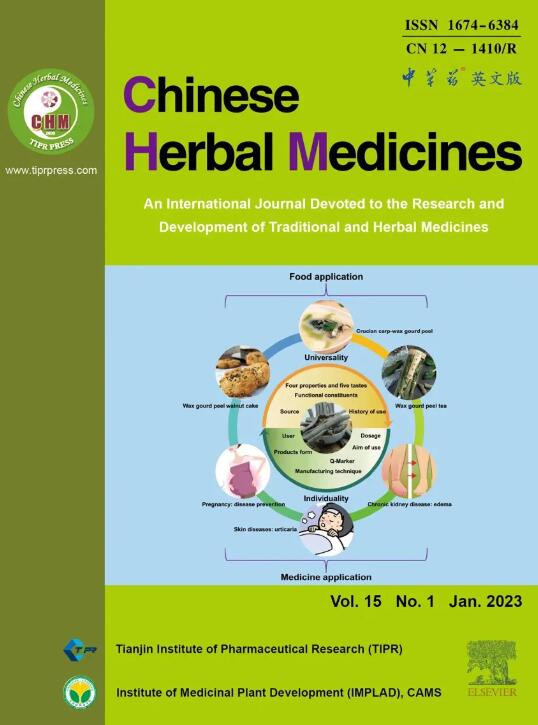DNA 代谢编码揭示根茎真菌群落
IF 8.9
4区 医学
Q1 CHEMISTRY, MEDICINAL
引用次数: 0
摘要
目的Zingiberis Rhizoma(ZR,中文名为干姜)是一种广受欢迎的香料和药材,已有数千年的使用历史。然而,在适当的条件下,干姜很容易受到真菌和霉菌毒素的污染,可能会危害消费者的健康和安全,因此人们对这种草药的安全性表示担忧。本研究旨在调查浙贝母中的真菌群落,以及采集地区和加工方法对真菌群落的影响。同时,根据处理方法将在四川省采集的样本分为三组。我们采用 Illumina MiSeq PE300 平台,以内部转录间隔序列 2(ITS2)为靶标,研究了 ZR 样品的真菌污染情况,以及不同采集地点和处理方法的样本群落中真菌群落的差异。Ascomycota 是主要的真菌门,占真菌读数的 34.46%-100%。在属的水平上,白色念珠菌属(Candida)、狄氏菌属(Diutina)和曲霉属(Aspergillus)是最主要的属,相对丰度分别为 0-98.37%、0-99.82% 和 0-79.08%。同时,还发现了 4 种潜在的致毒真菌和 7 种人类病原体。此外,还观察到来自四个采集地点和三种加工方法的 ZR 样品的群落组成存在差异。结论DNA 代谢编码为 ZR 样品中真菌群落多样性提供了新的见解,为确保 ZR 的可持续利用和质量研究提供了参考。本文章由计算机程序翻译,如有差异,请以英文原文为准。
DNA metabarcoding uncovers fungal communities in Zingiberis Rhizoma
Objective
Zingiberis Rhizoma (ZR, Ganjiang in Chinese), also known as dried ginger, is a popular spice and medicinal herb that has been used for several thousand years. However, ZR is easily contaminated by fungi and mycotoxin under suitable conditions, and might be hazardous to the health and safety of consumers, thus concerns about the herb’s safety have been raised. The aim of this study was to investigate the fungal community and the effects of collection areas and processing methods on the fungal community in ZR.
Methods
A total of 18 ZR samples were collected from four provinces of China, and the samples were divided into four groups based on collecting sites. Meanwhile, the samples collected in Sichuan Province, China were divided into three groups based on the processing methods. We employed the Illumina MiSeq PE300 platform and targeted the internal transcribed spacer 2 (ITS2) sequences to investigate fungal contamination in ZR samples, and the difference in fungal community among the groups of different collection sites and processing methods.
Results
All 18 samples were contaminated with fungi. Ascomycota was the dominant phyla, accounting for 34.46%−100% of the fungal reads. At the genus level, Candida, Diutina, and Aspergillus were the most dominant genera, with relative abundances of 0–98.37%, 0–99.82%, and 0–79.08%, respectively. Meanwhile, four potential toxigenic fungi and seven human pathogens were found. Furthermore, differences in the community composition of ZR samples from four collecting sites and three processing methods were observed.
Conclusion
DNA metabarcoding provides a novel insight into fungal community diversity in ZR samples, providing references to ensure the sustainable utilization and quality research of ZR.
求助全文
通过发布文献求助,成功后即可免费获取论文全文。
去求助
来源期刊

Chinese Herbal Medicines
CHEMISTRY, MEDICINAL-
CiteScore
4.40
自引率
5.30%
发文量
629
审稿时长
10 weeks
期刊介绍:
Chinese Herbal Medicines is intended to disseminate the latest developments and research progress in traditional and herbal medical sciences to researchers, practitioners, academics and administrators worldwide in the field of traditional and herbal medicines. The journal's international coverage ensures that research and progress from all regions of the world are widely included.
CHM is a core journal of Chinese science and technology. The journal entered into the ESCI database in 2017, and then was included in PMC, Scopus and other important international search systems. In 2019, CHM was successfully selected for the “China Science and Technology Journal Excellence Action Plan” project, which has markedly improved its international influence and industry popularity. CHM obtained the first impact factor of 3.8 in Journal Citation Reports (JCR) in 2023.
 求助内容:
求助内容: 应助结果提醒方式:
应助结果提醒方式:


